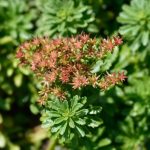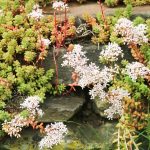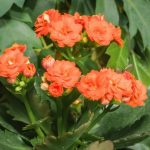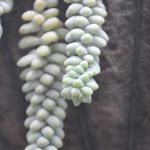Sedum ‘angelina’ is a type of Sedum rupestre that thrives in rock gardens and as a succulent groundcover. Read on for essential insights on cultivating and maintaining this plant!
If you’re seeking a low-maintenance, drought-tolerant, deer-resistant succulent that spreads in a mat-like growth pattern, look no further than Sedum angelina. This versatile perennial serves as an excellent groundcover or filler around larger plants, adding vibrant pops of color to your garden throughout the year. Its long flowering period also makes it a charming addition to containers.
During spring and summer, the foliage of Sedum angelina starts off as a bright green before transitioning to a golden yellow hue in autumn, bringing visual interest to your garden. In the summer, the plant showcases star-shaped yellow flowers, enhancing the beauty of your outdoor space. Furthermore, its cold-hardy nature makes it suitable for gardeners in northern regions, surviving the winter months with ease.
Whether planted as a groundcover, directly in the ground, in containers, or along rock walls, Sedum angelina thrives in sunny locations and adapts well to various soil types, as long as they are well-draining. Its needle-like foliage and long-lasting star-shaped yellow flowers bloom from mid to late summer through autumn, adding charm to your landscape.
Quick Care Guide
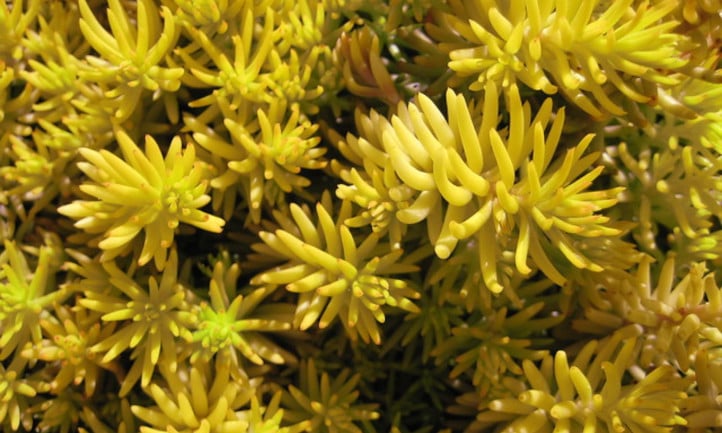

| Common Name | Stonecrop, Angelina stonecrop, creeping stonecrop, rocky stonecrop |
| Scientific Name | Sedum rupestre |
| Family | Crassulaceae |
| Height & Spread | 6 inches tall and 12 inches wide |
| Light | Full sun |
| Soil | Tolerates poor soil as long as it’s well-draining soil |
| Water | Drought tolerant once established |
| Pests & Diseases | Slugs and snails, root rot |
All About Sedum ‘Angelina’
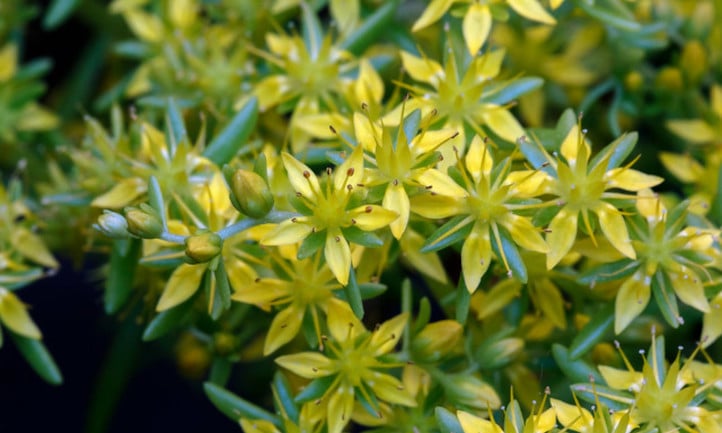

Native to mountain regions in central and western Europe, Angelina sedum, or Sedum rupestre, is commonly known as stonecrop due to its membership in the Crassulaceae family. The succulent features chartreuse needle-like leaves that encircle the stem, while producing golden-yellow star-shaped flowers during its bloom period from mid-summer to mid-fall.
The Sedum genus derives its name from the Latin word sedeo, which means to sit, reflecting the ground-hugging growth habit of many sedum species that sprawl over rocks and containers. Angelina’s evergreen nature in mild climates transitions to orange foliage in northern areas, blooming its star-shaped flowers from early summer to late fall in some regions. These hardy perennials flourish in USDA zones 5-9, spreading aggressively and serving as excellent groundcovers.
Sedum Angelina Care
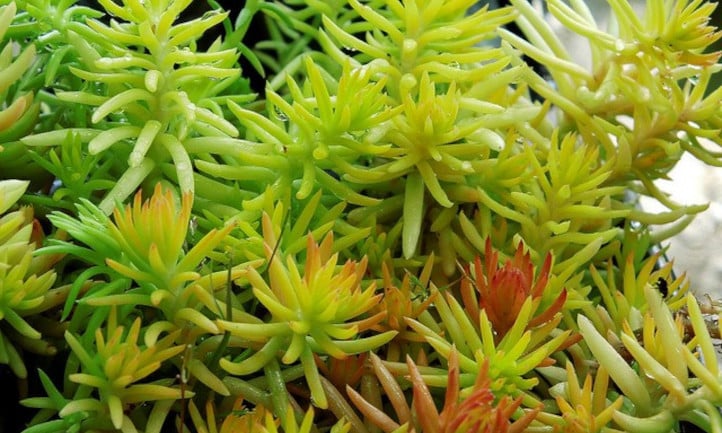

Easy to care for and low-maintenance, Angelina stonecrop thrives in both in-ground and container settings, making them ideal for landscapes that require minimal attention, especially with their deer-resistance.
Sun and Temperature
For optimal growth, plant Angelina sedum in full sun, ensuring it receives 6-8 hours of sunlight daily. While it can handle light shade, particularly in hot summers, its growth and flowering might slow down in consistent temperatures above 85 degrees. USDA zones 5-9 offer ideal conditions for these perennials, mimicking the climates of central and western Europe, their native regions. This resilience allows Angelina sedum to thrive in drought, heat, full sun, and even through winter.
At the close of the growing season,
Angelina sedum goes into dormancy when temperatures consistently drop below 40 degrees Fahrenheit. This natural dormancy provides protection against winter cold without needing extra care or specialized cold protection.
Water and Humidity
For Angelina stonecrop, it is best to water outdoors in the mid-morning or late afternoon to ensure the ground absorbs moisture instead of losing it through evaporation in full sun.
New plants need regular watering during the first growing season. Once established, Angelina sedum is highly drought-tolerant even in full sun. Overwatering can lead to waterlogging, so it’s better to let the soil dry between waterings.
When fully established, watering can be reduced to once every 1-2 weeks in summer and 2-4 weeks in spring and fall. Drip irrigation or soaker hoses are low-maintenance watering options.
During winter, reduce watering to once a month if there is no significant precipitation and temperatures stay above 40 degrees Fahrenheit.
Soil
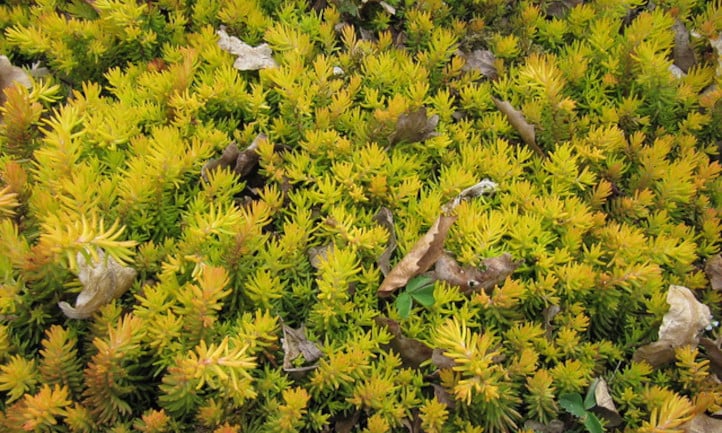

Sedums thrive in various soil types but prefer sandy, slightly acidic to neutral soil with good drainage. Avoid waterlogged areas and opt for full sun spots in sandy or rocky soil.
For container-grown plants, ensure well-drained potting mix with added rocks for drainage, or mix perlite or sand into the potting mix. Soggy soil can be fatal to sedum plants.
Fertilizing Sedum Rupestre Species
Angelina stonecrop thrives in lean soil and doesn’t require fertilization as it can harm the plant. A thin layer of compost at the start of the growing season provides ample nutrients for container-grown and in-ground plantings.
Pruning Sedum Rupestre Species
Your Angelina stonecrop sedum doesn’t need regular pruning as it is a low-growing plant. Trim terminal clusters to control growth and remove dead or damaged foliage to promote new growth.
Sedum Rupestre Propagation
Propagate Sedum rupestre with softwood cuttings in early summer or divide mature plants as ground cover in spring. New cuttings require regular watering until established.
Troubleshooting Sedum Rupestre Species


Angelina stonecrop is disease-resistant but watch for potential issues due to waterlogging or extreme heat. Ensure good drainage and avoid planting in low-lying areas prone to water accumulation.
Pests
Angelina stonecrop is generally pest-resistant except for occasional damage from slugs and snails. Use slug and snail bait or try beer as a natural alternative for control if damage becomes significant.
Using a clever gardening hack, bury the container with sedum rupestre Angelina ground cover so that slugs and snails can’t escape once they fall in. Fortunately, you’ll be spared from dealing with pesky deer or rabbits bothering this plant. If root rot becomes an issue, it’s typically due to poor drainage, especially in shady and waterlogged locations. Opt for planting in rock walls with good drainage rather than overly rich soil. Consider the vertical aspect of rock walls as a natural deterrent for water accumulation. Should you observe signs of root rot, like wilting and browning of foliage, promptly remove affected parts and relocate the plant to drier, well-drained soil.
For those inquisitive about sedum rupestre Angelina, here are some common questions addressed:
1. Is Angelina sedum an annual or perennial plant?
Angelina sedum is an evergreen perennial.
2. Does Angelina sedum require full sun?
Yes, it thrives in full sun but can tolerate some light shade in regions with scorching summers.
3. Is Angelina sedum a fast-spreading plant?
In favorable conditions, this plant can indeed spread rapidly, forming a lush mat-like cover.
4. Is sedum Angelina harmful to pets?
Fortunately, sedum rupestre Angelina is non-toxic to dogs, cats, and humans, making it a safe choice for gardens or containers.
5. How can I propagate sedum Angelina?
You can easily divide and replant this evergreen in early spring or autumn, allowing you to expand its presence in your garden.

